HomeReviewsNightingale
Nightingale early access review: a numbers grind disguised as a gaslamp survival gameI simply can’t escape the rarity rainbow
I simply can’t escape the rarity rainbow
Image credit:Rock Paper Shotgun/Inflexion Games
Image credit:Rock Paper Shotgun/Inflexion Games

Not long ago, a few of us from the RPS Treehousewandered throughfirst-person survival ‘em upNightingalewith its boss Aaryn Flynn, and thenhad it outabout the game’s crafting menus. I was one of the folks who wasn’t so hot on what we’d played, and I’d hoped that the early access version would prove me wrong.
Alas, I am sad to report that I still do not likeNightingale. From what I’ve played so far, the game is an awkward marriage ofsurvival gameand live service loot grind, which makes you feel divorced from the very world you inhabit.
For full transparency, I haven’t reached the endgame, but I’ve tried to pack in as much play time as I can. This review isn’t from someone who’s built a second life in the magic woods, but from the perspective of an individual who gave it an honest go. I suppose the question I can answer is: would I havewantedto spend hundreds of hours with Nightingale and push through to its endgame? And that’s a hard no from me, chief.
Image credit:Rock Paper Shotgun/Inflexion Games
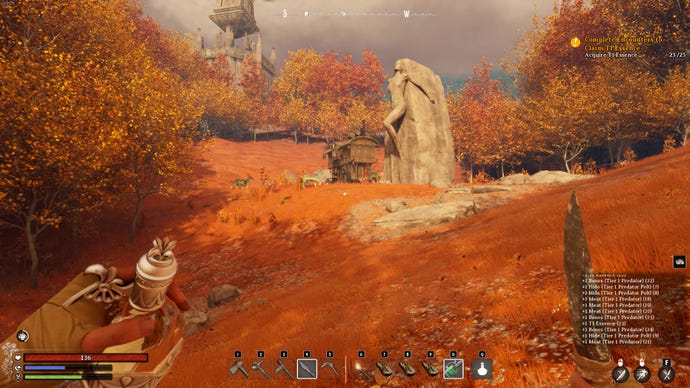
Nightingale’s setup is, initially, quite compelling. Humans had this arcane portal network where they could travel between realms and be merry, but it collapsed because of a mysterious cataclysm called The Pale. So you’re one of many, dubbed Realmwalkers, who’ve been left scattered in the portal network and who’d like to reach the safety of a steampunk, Victorian era-esque city called Nightingale.
Off the bat you meet Puck, a floating lad with a mask who speaks in teapot English. He’s basically a helpful guide who teaches you how to craft workbenches and structures the survival activities you partake in. Quickly, though, you realise that Nightingale and its realm-hopping premise are a bundle of wood logs in a trench coat. The fun Victorian gear you started off with? That cool waistcoat? The nice tie? Get it off! Puck wants you to make a campfire, pick up some rocks, and outfit yourself like a caveman.
Eventually, the rhythm of the game establishes itself. You select one realm as your ‘ome (plonk down a marker and it’ll become your “respite realm”), which you can fast travel to it from wherever you might be. And it’s at your respite realm where you set up your base, storage, and things like that. To progress, you unlock and craft cards that generate progressively trickier worlds based on the combinations you’ve slapped into the portals you’ve built. One card determines the biome (desert, swamp, forest), while the other is called something fancy like Astrolabe or Herbarium, but actually just determines the difficulty level of its inhabitants.
Image credit:Rock Paper Shotgun/Inflexion Games
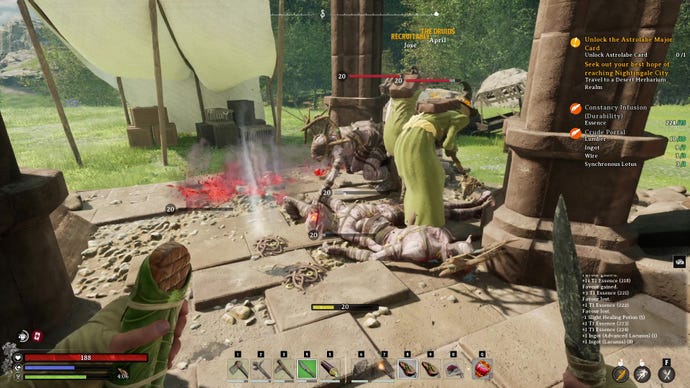
Perhaps Nightingale’s greatest crime is how it divorces discovery from exploration. Where other survival games integrate progression into the minerals and materials of the very earth you walk, Nightingale’s unlocks come from… vendors. InValheim, for instance, survival and discovery intertwine as iron ore outfits you with the armour and tools you need to mine or chop whatever’s next in line: rags, iron, carapace, Louis Vuitton. There’s a sense you’re shaping the landscape into a series of stepping stones. With Nightingale, discovery is reliant on a shopkeeper and whether you’ve got enough of a currency called Essence to give them.
Essence is broken down into tiers and it’s what you’ll need to repair your things, buy new recipes, and upgrade your equipment. The better the equipment you want to unlock and upgrade, the higher the tier of Essence you’ll be working with. And to get large amounts of the stuff, you need to complete activities dotted around the map that further reinforce grind.
Image credit:Rock Paper Shotgun/Inflexion Games
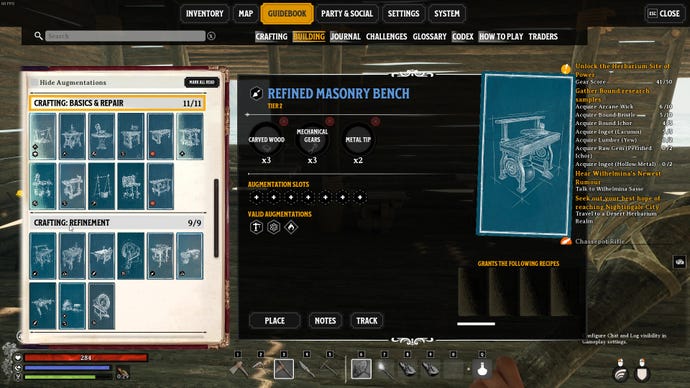
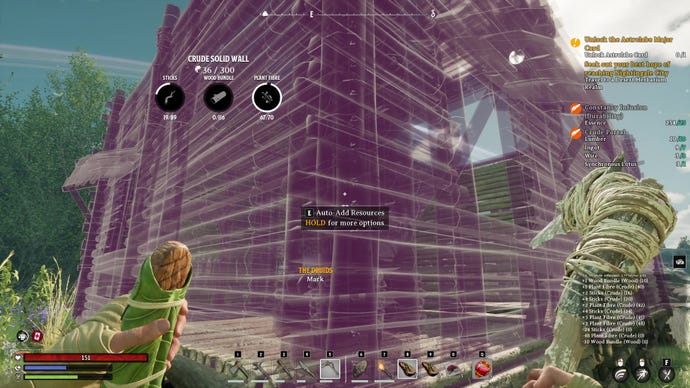
Image credit:Rock Paper Shotgun/Inflexion Games
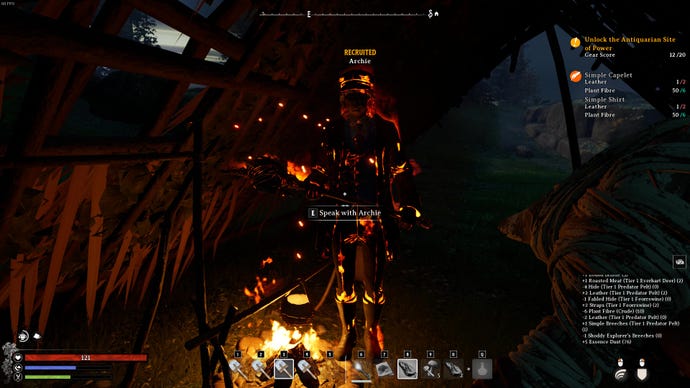
No matter where you are - desert, forest, swamp - the activities remain largely the same. There are small parkour puzzles where you awkwardly mantle up to an Essence paycheck. “Occupations”, where you batter enemies who awkwardly spawn into small caverns or huts. “Puzzle towers” where you’ve got to awkwardly memorise certain tunes in order, awkwardly find some glyphs scrawled on the walls.
My faves are the Occupations that see you transported through a portal into a puzzle zone, where you’ve got to do battle with enemies and maybe find some glyphs. “Favourite” might be a strong descriptor here, but they at least offered a slight sense of adventure. Each biome is also home to a big Fae Tower, which looks quite the part but devolves into what’s actually a sequence of mini events ripped from the other activities, except there’s a boss fight against a big robot at the end. The robot is basically the same every time.
Manage to complete a Fae Tower and you’ll unlock all the activity icons across the map, making it easier to barrel between them in your quest for Essence. Not only that, but you can bang a Minor card into the tower to alter the world a bit more. Many of these curl the monkey’s paw, in that you might benefit from extra resources but your stamina tanks a little to compensate. Some are genuinely quite fun, like one that makes it so you harvest meat from trees, or another where you’re able to jump and float high in the air. Skyboxes react in novel ways, too, glistening with fractures or turning deep crimson.
Image credit:Rock Paper Shotgun/Inflexion Games
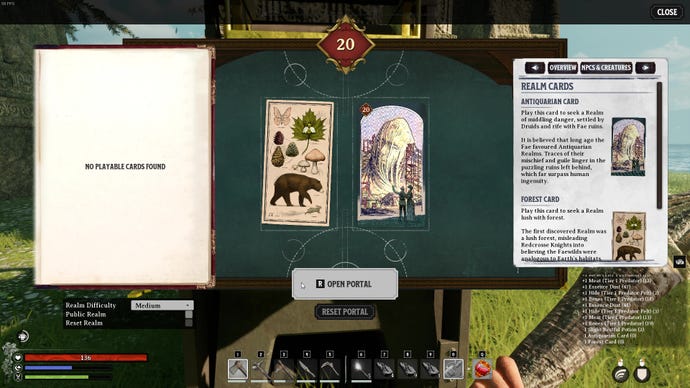
Fighting your way to the top isn’t great, at least early to mid game. Combat is Elder Scrolls: Oblivion levels of floatiness, but somehow worse, with hits that rarely register and little strategy needed to overcome dunce AI. Double-barrel shotguns and large hammers with magical powers do lend later fights extra crunch, but you’re forever wrangling with jank that tires more than it amuses.
Elsewhere, much of your time is spent grinding out Essence to feed a clunky crafting system with a UI in desperate need of a retooling. Everything, like your benches and whatnot are all organised into separate drop down menus. Click on each individual thing and you can see what material is required to build them; all intuitive and useful for a beginner who hasn’t unlocked much. But as you progress the drop down menus expand into a confusing sprawl of lists that would fry even the hardiest supercomputer. Knowing what to get, which vendor youmightneed to buy it from, and what biome you need to have unlocked, eventually muddies the game’s clear quest progression.
The endless lists speak to a bigger issue, which is the game’sobsessionwith materials. There are different types of hide, like predator hide, or prey hide, or special hide from a boar with a name, or the hide you’ve snipped off seek’s back. Not only do they all share the same icon, making them a nightmare to organise or craft with, but they’re only the beginning.
While I think survival games have stagnated, I believe there’s some fundamentals to the formula that aren’t worth straying from, i.e., work benches. Again, good survival games have you upgrade rickety benches into arcane benches that churn out starter things, but also do better versions of the starter thing. Clutter is kept to a minimum because you’re bettering foundations. Nightingale largely does away with this system, forcing you to turn your home into a maze of contraptions, all of which do a handful of very specific things.
Image credit:Rock Paper Shotgun/Inflexion Games
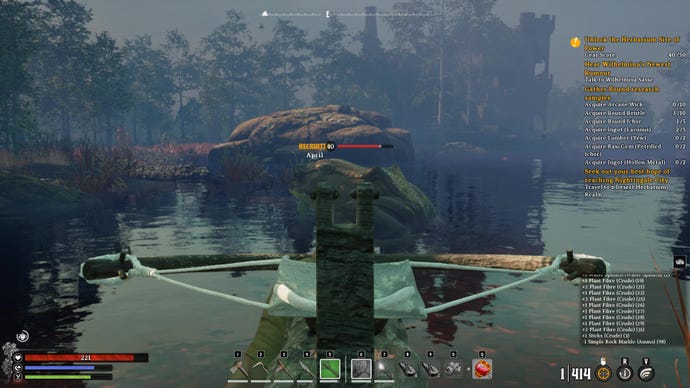
Not everything about building is agony, though. There’s some nuance to crafting armour or weaponry using special versions of a material, like getting extra bonuses or a unique colour combination from an insect’s shell. And at times, there’s a real sense of accomplishment when you craft a buffed piece of armour or pop down a station you’ve worked hard towards. Like other games where numbers go up, it’s hard not to ignore the hungry gnats in your brain who clamour for those sweet percentage increases.
While I understand Nightingale’s in early access and things are subject to a tweaking, I can’t help but feel that its problems lie deeper than surface level numbers and UI. I respect how it’s tried to push the survival genre forward with its realm-hops and gear scoring, but both of these fundamentals aren’t implemented very well. The realms strike me as re-skins once the novelty’s worn off, and the way progress is tied to numbers only serves to make survival feel like a grind. Unless things change dramatically, I think I’ll pass on reaching Nightingale.